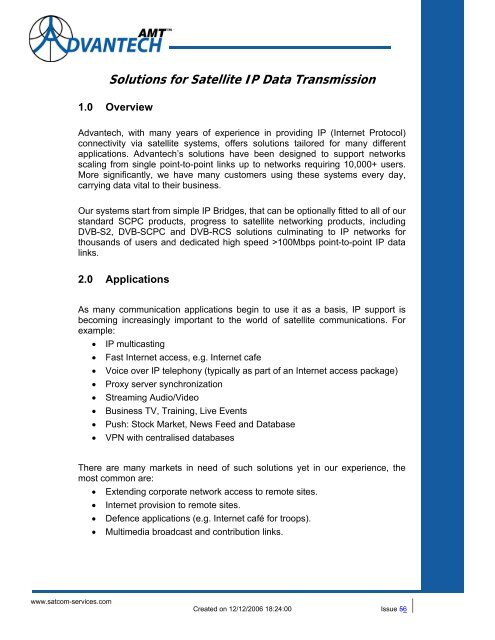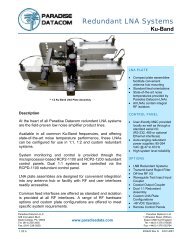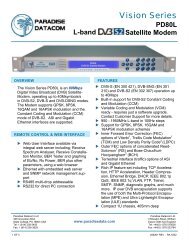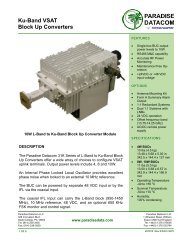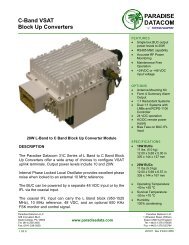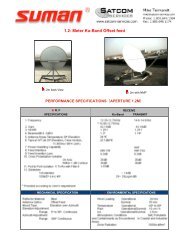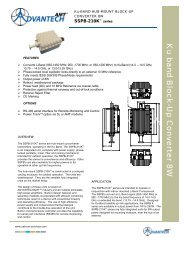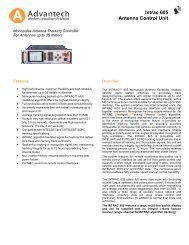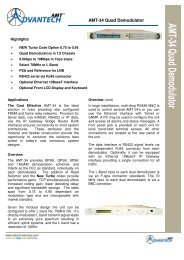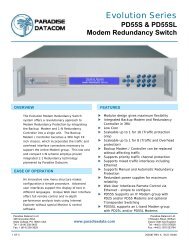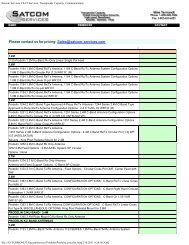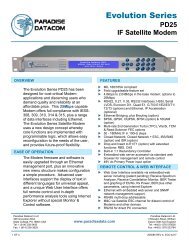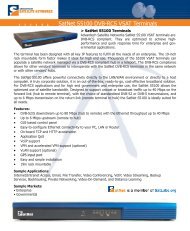Solutions for Satellite IP Data Transmission - Satcom Services
Solutions for Satellite IP Data Transmission - Satcom Services
Solutions for Satellite IP Data Transmission - Satcom Services
Create successful ePaper yourself
Turn your PDF publications into a flip-book with our unique Google optimized e-Paper software.
<strong>Solutions</strong> <strong>for</strong> <strong>Satellite</strong> <strong>IP</strong> <strong>Data</strong> <strong>Transmission</strong><br />
1.0 Overview<br />
Advantech, with many years of experience in providing <strong>IP</strong> (Internet Protocol)<br />
connectivity via satellite systems, offers solutions tailored <strong>for</strong> many different<br />
applications. Advantech’s solutions have been designed to support networks<br />
scaling from single point-to-point links up to networks requiring 10,000+ users.<br />
More significantly, we have many customers using these systems every day,<br />
carrying data vital to their business.<br />
Our systems start from simple <strong>IP</strong> Bridges, that can be optionally fitted to all of our<br />
standard SCPC products, progress to satellite networking products, including<br />
DVB-S2, DVB-SCPC and DVB-RCS solutions culminating to <strong>IP</strong> networks <strong>for</strong><br />
thousands of users and dedicated high speed >100Mbps point-to-point <strong>IP</strong> data<br />
links.<br />
2.0 Applications<br />
As many communication applications begin to use it as a basis, <strong>IP</strong> support is<br />
becoming increasingly important to the world of satellite communications. For<br />
example:<br />
• <strong>IP</strong> multicasting<br />
• Fast Internet access, e.g. Internet cafe<br />
• Voice over <strong>IP</strong> telephony (typically as part of an Internet access package)<br />
• Proxy server synchronization<br />
• Streaming Audio/Video<br />
• Business TV, Training, Live Events<br />
• Push: Stock Market, News Feed and <strong>Data</strong>base<br />
• VPN with centralised databases<br />
There are many markets in need of such solutions yet in our experience, the<br />
most common are:<br />
• Extending corporate network access to remote sites.<br />
• Internet provision to remote sites.<br />
• Defence applications (e.g. Internet café <strong>for</strong> troops).<br />
• Multimedia broadcast and contribution links.<br />
www.satcom-services.com<br />
Created on 12/12/2006 18:24:00 Issue 56
<strong>Satellite</strong> communications equipment is now completely network-aware and<br />
provides a full network stack above the transmission layer. Advantech has<br />
acknowledged this and offers diverse network capabilities in its product portfolio.<br />
An <strong>IP</strong>-based satellite network can be seen as an <strong>IP</strong> network cloud. In a typical<br />
star configuration, the network consists of access terminals and a satellite<br />
gateway or hub. The <strong>IP</strong> capabilities of the satellite modem can vary depending<br />
on the site requirements. For access terminals, the set of <strong>IP</strong> features offered by<br />
Advantech include:<br />
• DHCP<br />
• NAT/PAT<br />
• VLAN<br />
In addition to these standard access features, Advantech <strong>IP</strong> networks offer<br />
industry-leading capabilities including:<br />
• TCP and HTTP Acceleration<br />
• Level 3 QoS<br />
• Encryption<br />
• Firewall/Packet Filtering<br />
• Static and Dynamic Routing<br />
• AAA (Authentication, Authorization and Accounting)<br />
• <strong>IP</strong> <strong>Services</strong> including DNS and FTP/TFTP<br />
Advantech <strong>IP</strong> products are entirely SNMP manageable and offer additional<br />
configuration interfaces including CISCO TM -like command line interfaces and<br />
HTTP graphical management.<br />
The complete list of <strong>IP</strong> features are described in the <strong>IP</strong> Gateway data sheet,<br />
which is available from the by contacting us: Joyce@satcom-services.com<br />
Advantech satellite <strong>IP</strong> networks can be classified in three families:<br />
• DVB-based two-way satellite networks (with SCPC or RCS return links)<br />
[Section Error! Reference source not found.3.0]<br />
• SCPC Star networks [Section 4.0]<br />
• High speed backbone / high speed distribution links [Section 6.0]<br />
www.satcom-services.com<br />
Created on 12/12/2006 18:24:00 Issue 56
The selection of one of these networks is based on service-provider<br />
requirements including the <strong>IP</strong> services, network size and integration with existing<br />
networks. The selection criteria are described in more detail in Section 5.0.<br />
DVB-based two-way satellite networks (SatNet) support a service-provider’s<br />
network requirements at all stages of network deployment, offering low initial<br />
investment that subsequently grows in-line with network expansion. Starting from<br />
small-scale SCPC networks, the network evolves to a DVB-RCS MF-TDMA<br />
network. The key aspect of this approach, known as SatNet Pay-as-You-Grow TM ,<br />
is the re-use of user terminal equipment in both SCPC and RCS. This offers the<br />
service-provider major cost savings as their network size grows.<br />
The DVB-SCPC and DVB-RCS SatNet solutions rely on the DVB standards on<br />
both the <strong>for</strong>ward and return links and offers an integration path with existing<br />
service-provider infrastructure.<br />
The SCPC Star network solutions are based on the AMT60 product and offer<br />
increased bandwidth efficiency through the use of HDLC framing on the satellite<br />
link. Well-suited to dedicated high quality links that require fixed bandwidth, the<br />
SCPC Star network can also operate with a star topology DVB <strong>for</strong>ward link <strong>for</strong><br />
integration in existing MPEG multiplexers.<br />
www.satcom-services.com<br />
Created on 12/12/2006 18:24:00 Issue 56
3.0 Advantech SatNet <strong>Solutions</strong> (DVB-SCPC & DVB-RCS)<br />
Advantech offers the most scalable solutions of the industry available at the most<br />
competitive cost. The SatNet Pay-as-You-Grow approach supports the service<br />
provider's requirements at all stages of a network deployment. Starting from an<br />
SCPC-based network, our strategy enables the network operator and service<br />
provider to migrate to DVB-RCS while re-using the same user terminal<br />
equipment and <strong>for</strong>ward link equipment. This allows to easily grow the system<br />
from a few SCPC terminals to hundreds of DVB-RCS terminals. Further, the<br />
Pay-as-You-Grow strategy makes it possible to scale up the DVB-RCS hub<br />
from hundreds of terminals to tens of thousands of terminals.<br />
3.1. DVB-SCPC<br />
The DVB-SCPC SatNet solution combines a high rate <strong>for</strong>ward link with a set of<br />
discrete return link carriers providing dedicated bandwidth to each of the user<br />
terminals. DVB-SCPC networks offer the advantages of being easily installed<br />
www.satcom-services.com<br />
Created on 12/12/2006 18:24:00 Issue 56
TALK / DATA<br />
TALK<br />
RS CS TR RD TD CD<br />
TALK / DATA<br />
TALK<br />
RS CS TR RD TD CD<br />
and have lower operational costs, particularly at initial network deployment. The<br />
hard committed bandwidth of SCPC is also attractive to many users of SCPC<br />
networks.<br />
The DVB-SCPC network architecture is shown in below:<br />
<strong>IP</strong> Encapsulator<br />
AMT-70<br />
AMT-34<br />
1:N<br />
Splitter<br />
S5400<br />
S5400<br />
Customer<br />
LAN<br />
Customer<br />
LAN<br />
Optional<br />
Router<br />
AMT-34<br />
HUB<br />
TERMINALS<br />
Figure 1: DVB-SCPC Network Architecture<br />
Forward Link<br />
The <strong>for</strong>ward link is based on the DVB-S/S2 standard (EN 300 421/ EN 302 307)<br />
used <strong>for</strong> digital video broadcasting. The <strong>for</strong>ward link carrier rate can vary from 1-<br />
45MBaud with data rates of up to 80Mbps (limited by terminal throughput).<br />
The <strong>for</strong>ward link uses Multi-Protocol Encapsulation (MPE) of <strong>IP</strong> data into MPEG<br />
frames. An Advantech encapsulator is used in the Gateway <strong>for</strong> data<br />
encapsulation; however, this architecture is suited to introduction of 3 rd party<br />
encapsulators.<br />
Return Link<br />
The return link is an MPEG-based SCPC carrier that utilizes the coding available<br />
in DVB-RCS. To maximize return link bandwidth efficiency, section packing is<br />
used in conjunction with MPE.<br />
The return link supports both QPSK and 8PSK modulation.<br />
www.satcom-services.com<br />
Created on 12/12/2006 18:24:00 Issue 56
DVB-SCPC Micro Hub<br />
The DVB-SCPC Micro Hub is an IF (L-band or 70/140 MHz) - Ethernet integrated<br />
modem-router equipment chain that provides access to the terrestrial network.<br />
The hub consists of a single broadcast <strong>for</strong>ward transmit chain in conjunction with<br />
return links comprising of banks of SCPC receivers. Both the broadcast <strong>for</strong>ward<br />
link and SCPC return receivers have Ethernet interfaces and there<strong>for</strong>e can be<br />
configured to suit the network infrastructure of the hub. All that is required is to<br />
close the <strong>IP</strong> loop in the regular switch/hub device.<br />
AMT34: 4-Channel SCPC Integrated Receiver Router<br />
The AMT34 can be configured as a quad receiver <strong>for</strong> the scalable architecture.<br />
When configured <strong>for</strong> this architecture, the AMT34 includes the <strong>IP</strong> Gateway,<br />
MPEG to <strong>IP</strong> de-capsulation and offers a native 10/100BT Ethernet interface. The<br />
AMT34 can be easily integrated into the gateway <strong>IP</strong> infrastructure as required by<br />
the end-customer.<br />
<strong>IP</strong> Encapsulator<br />
The SCPC Encapsulator is an Ethernet to ASI <strong>IP</strong> Encapsulator. This<br />
encapsulator per<strong>for</strong>ms standard MPE encapsulation of <strong>IP</strong> and interfaces to the<br />
modulator via ASI. Advantech provides an extremely cost-effective <strong>IP</strong>E solution<br />
<strong>for</strong> this application. Additionally, 3 rd party encapsulators may also be used <strong>for</strong><br />
meeting specific customer requirements.<br />
AMT70 Modulator<br />
The AMT70/75 DVB-S/S2 modulator is configured with an ASI interface <strong>for</strong><br />
connection to the <strong>IP</strong> Encapsulator.<br />
3.2. DVB-RCS<br />
In its standard <strong>for</strong>m, a DVB-RCS network is a star-based VSAT network<br />
providing access to the Internet and related networks. Advantech offers a<br />
compact RCS system that supports up to thousands of user terminals, and<br />
beyond, in this architecture. In addition, the capabilities of this network go<br />
beyond standard RCS to offer 8PSK return links and mesh capabilities, DVB-S2<br />
ACM, as well as dual SCPC/RCS return link capabilities.<br />
www.satcom-services.com<br />
Created on 12/12/2006 18:24:00 Issue 56
Forward Link<br />
The <strong>for</strong>ward link is based on the DVB-S/S2 standard (EN 300 421/ EN 302 307)<br />
used <strong>for</strong> digital video broadcasting. The <strong>for</strong>ward link carrier rate can vary from 1-<br />
45MBaud (DVB-S) with data rates of up to 80Mbps.<br />
The <strong>for</strong>ward link uses Multi-Protocol Encapsulation (MPE) of <strong>IP</strong> data into MPEG<br />
frames. As with the DVB-SCPC network, an Advantech-provided encapsulator is<br />
available and the architecture supports 3 rd party encapsulators.<br />
Return Link<br />
The return link is Multi-Frequency TDMA. Each TDMA carrier can range from<br />
64kbps to 8Mbps. The terminal is capable of frequency hopping among the<br />
return link carriers to ensure maximum use of return link bandwidth. A hub-based<br />
scheduler provides dynamic bandwidth control.<br />
The transmission by terminals on the return link is controlled via the hub – only<br />
logon burst use random access. Individual terminals can be assigned constant<br />
bandwidth or the terminal can make dynamic bandwidth requests. These two<br />
mechanisms can be combined to guarantee each terminal a minimum bandwidth<br />
while allowing access to a complete return link carrier bandwidth <strong>for</strong> short<br />
periods.<br />
The inbound return links support concatenated RS/Convolutional or Turbo<br />
Convolutional encoding, using QPSK modulation and with an option <strong>for</strong> 8PSK<br />
available.<br />
Return link bandwidth is assigned to user terminals in a Burst Time Plan. The<br />
bandwidth scheduling algorithms support Committed In<strong>for</strong>mation Rate (CIR) and<br />
dynamic packet-by-packet bandwidth requests. This provides an exceedingly<br />
flexible mechanism <strong>for</strong> scheduling individual terminals in regards to Service<br />
Layer Agreements (SLAs).<br />
DVB-RCS Micro, Mini & Max Hubs<br />
The DVB-RCS Hub product portfolio consists of equipment-scalable rack units<br />
that operate both as a DVB-RCS modem and as a network manager providing<br />
access to the DVB-RCS network. The product line consists of the Micro, Mini<br />
and Max hubs, capable of supporting networks as small as 20 terminals and as<br />
large as 10,000 terminals, and beyond.<br />
www.satcom-services.com<br />
Created on 12/12/2006 18:24:00 Issue 56
Management<br />
Ethernet<br />
Traffic<br />
Ethernet<br />
Network Manager<br />
Router<br />
Encapsulator<br />
10MHz<br />
1pps<br />
ASI<br />
Ethernet<br />
AMT-70<br />
Modulator<br />
with NCR<br />
Burst<br />
Demodulator<br />
Figure 2: DVB-RCS Hub Schematic<br />
AMT70 Modulator<br />
The hub uses the Advantech AMT70 Universal Modem. The AMT70 supports a<br />
broad range of transmission standards including both DVB-S and DVB-S2. As<br />
part of RCS network synchronization, the AMT70 supports NCR time stamping<br />
and synchronization via 10MHz and GPS’ 1pps inputs.<br />
The AMT70 supports the full range of DVB-S/S2 coding and modulation.<br />
Burst Demodulator<br />
The hub burst demodulator is a full IF to baseband multi-carrier demodulator<br />
(MCD). Packaged as a single rack-mount unit, the MCD supports an L-band<br />
interface, per<strong>for</strong>ms frequency de-multiplexing, burst demodulation and decoding<br />
and <strong>IP</strong> reassembly.<br />
Features of the MCD include:<br />
• L-band interface (950 to 2150 MHz).<br />
• Maximum Throughput: 24Mbps<br />
• Maximum Bandwidth: 34MHz<br />
• Supported Traffic Encapsulation Format: 1 & 2 ATM and MPEG<br />
www.satcom-services.com<br />
Created on 12/12/2006 18:24:00 Issue 56
• Symbol Rate: Selectable per carrier<br />
• Burst Format: Selectable per carrier<br />
• Maximum number of carriers per MCD: 96<br />
• Carrier rates: 64kbps to 8Mbps<br />
• Channel spacing: 1.25 to 1.50 (variable)<br />
• QPSK and 8PSK demodulation.<br />
• Timing, Power and Frequency Measurements on a burst-by-burst basis.<br />
• Turbo or RS-V FEC decoder.<br />
• 10MHz/1pps synchronization including NCR loading.<br />
Network Manager/Router/Encapsulator<br />
The main features are:<br />
• Network Manager<br />
♦ Network entry and exit control<br />
♦ Return link bandwidth scheduling<br />
♦ Configuring the return link<br />
♦ Monitoring the per<strong>for</strong>mance of terminals on the return link<br />
♦ Monitoring overall network per<strong>for</strong>mance<br />
• Router<br />
♦ Forwarding of <strong>IP</strong> traffic between the satellite and terrestrial networks<br />
♦ <strong>IP</strong>-Layer traffic shaping (using an optional traffic shaper)<br />
♦ Level 3 QoS<br />
♦ Terrestrial Routing Protocols<br />
• Encapsulator<br />
♦ MPE encapsulation of user <strong>IP</strong> traffic<br />
♦ Insertion of RCS tables<br />
♦ Support <strong>for</strong> 3 rd Party encapsulators<br />
3.3. DVB-SCPC/RCS Terminals<br />
Advantech offers a portfolio of terminal products <strong>for</strong> the DVB-based two-way<br />
SatNet solutions. These terminals are built on field-proven DVB-RCS technology<br />
that has been deployed worldwide. Advantech Satnet terminals are DVB-RCS<br />
standard compliant and offer additional value-added features that enable the<br />
service-provider to increase their return on investment. Key features of the<br />
terminal portfolio include:<br />
• Full-featured <strong>IP</strong> networking including QoS<br />
www.satcom-services.com<br />
Created on 12/12/2006 18:24:00 Issue 56
• DVB-S and S2 Forward Links<br />
• SCPC and DVB-RCS Return Links<br />
• High Forward Link Throughput (36Mbps sustained)<br />
• High Return Link Throughput (up to 8Mbps)<br />
• Higher Order Return Link Modulation (8PSK)<br />
• Local and remote management via SNMP, HTTP and Command Line<br />
Interface<br />
• Installation support including scripts and antenna alignment tools<br />
• Reliable remote software upgrade<br />
• Flexible multicasting<br />
• Industry standard BUC/LNB Interface with 2-cable IFL<br />
The Advantech SatNet terminal portfolio consists an Indoor Unit (IDU) and<br />
Outdoor Unit (ODU). Two product lines are available: the af<strong>for</strong>dable Series 4000<br />
(with Model S4100) and the enterprise-oriented Series 5000 (with Models<br />
S5100/5200/5300/5400). Both product lines support DVB-S and DVB-S2. The<br />
Series 5000 supports as well Mesh connectivity, DVB-S2 ACM mode, and SCPC<br />
transmission mode (<strong>for</strong> DVB-SCPC satellite networks). There is also a receiveonly<br />
terminal (ROT) supporting both DVB-S and DVB-S2 called based on the<br />
Model S1010 IDU.<br />
Figure 2: DVB-RCS Terminal Schematic<br />
www.satcom-services.com<br />
Created on 12/12/2006 18:24:00 Issue 56
4.0 SCPC Star Network <strong>Solutions</strong> (AMT60/65)<br />
The AMT60/65 system provides an SCPC network combining a high rate <strong>for</strong>ward<br />
link with a set of discrete return link carriers providing dedicated bandwidth to<br />
each of the user terminals. SCPC Networks offer the advantages of being easily<br />
installed and have lower operational costs, particularly at initial network<br />
deployment. The hard committed bandwidth of SCPC is also attractive to many<br />
users of SCPC networks.<br />
The AMT60 system can be scaled from QPSK to 16-ary constellations on both<br />
<strong>for</strong>ward and return link while the return link can support up to 10Mbps sustained<br />
throughput. In addition, AMT60 systems can operate as either MPEG-TS MPE<br />
encapsulation, or HDLC (Frame Relay), consequently further improving<br />
spectrum efficiency. The SCPC network architecture is shown below:<br />
AMT-70 U/C PA<br />
Router<br />
Forward Link<br />
HUB<br />
AMT34<br />
<strong>IP</strong> G/W<br />
D/C<br />
LNB<br />
Return Link<br />
Frame Relay System<br />
RFFE<br />
AMT61<br />
Terminal<br />
RFFE<br />
AMT61<br />
Terminal<br />
RFFE<br />
AMT61<br />
Terminal<br />
RFFE<br />
AMT61<br />
Terminal<br />
Figure 3: Frame Relay based AMT60 series Solution<br />
www.satcom-services.com<br />
Created on 12/12/2006 18:24:00 Issue 56
4.1 Hub System<br />
The hub <strong>for</strong> this system does not require an MPEG Encapsulation unit. This<br />
saves both money and link capacity, as MPEG Encapsulation typically adds<br />
approximately 16% to 20% overhead on top of the data. This function is replaced<br />
by HDLC (Frame Relay) encapsulation inside the AMT70 Modulator. The<br />
Modulator is equipped with a high speed (full 10/100 Base-T) <strong>IP</strong> Gateway card<br />
and the HDLC encapsulation is implemented on this card. The Modulator can<br />
transmit any of the supported AMT70 series modulation / coding systems<br />
(Intelsat / DVB-S / DVB-DSNG / Turbo (eTPC) or DVB-S2 LDPC/BCH). This<br />
would allow a Turbo 16QAM or 16APSK DVB-S2 <strong>for</strong>ward link. The DVB-S2<br />
<strong>for</strong>ward link operates in Generic stream mode, which treats the <strong>for</strong>ward link as a<br />
pure serial data stream.<br />
The return path reception in the hub is very similar to the DVB-SCPC and DVB-<br />
RCS satellite networking systems. It is implemented using AMT34 Quad<br />
Demodulator units including the <strong>IP</strong> Gateway card. However, in this system there<br />
is no need <strong>for</strong> an MPEG De-capsulation function in the return path. This function<br />
is replaced by an HDLC De-framer. Each of the Quad units has only one 10/100<br />
Base-T output and aggregates the received data from 4 different remote<br />
terminals into one <strong>IP</strong> data flow. Note that it is possible to construct VLANs within<br />
the AMT60 system allowing different <strong>IP</strong> networks to use the common<br />
transmission network without compromising each users network security.<br />
4.2 AMT60/65 Series Terminal products<br />
The AMT60 series supports a number of different terminals. The AMT60 is a<br />
receive-only high-end IDR solution <strong>for</strong> users who utilize an alternative return path<br />
technology. The receiver can support DVB-S / DVB-DSNG (8PSK/16QAM) /<br />
Intelsat and Turbo (QPSK/8PSK and 16QAM) modes and can operate from<br />
64kbps/S up to >100 Mbps/S.<br />
The AMT61 sister product provides both receive and transmit functionality. The<br />
receiver is identical to the AMT60 and the transmitter is based on Advantech’s<br />
AMT30 series product and provides QPSK/8PSK/16QAM modulation with<br />
Intelsat and Turbo encoding. The AMT65 is similar to the AMT61 but offers DVB-<br />
S2 receive functionality. All these products are 1RU 19inch Rack Mount units<br />
with a built-in <strong>IP</strong> Gateway and HDLC encapsulation / de-capsulation.<br />
www.satcom-services.com<br />
Created on 12/12/2006 18:24:00 Issue 56
AMT61 Integrated Terminal (1RU 19inch Rack)<br />
10/100<br />
Base-T<br />
<strong>IP</strong><br />
Gateway<br />
AMT30<br />
Modulator<br />
L Band<br />
Demodulator<br />
DVB-S/ DSNG/ S2/ Turbo<br />
Figure 4: AMT61/65 Terminal Architecture<br />
This architecture enables very powerful high-speed <strong>IP</strong> terminals with guaranteed<br />
latency and throughput.<br />
www.satcom-services.com<br />
Created on 12/12/2006 18:24:00 Issue 56
4.3 AMT60/65 Forward link example with MPEG<br />
MPE AMT-70 U/C PA<br />
Router<br />
Forward Link<br />
HUB<br />
AMT34<br />
<strong>IP</strong> G/W<br />
D/C<br />
LNB<br />
Return Link<br />
RFFE<br />
AMT61<br />
Terminal<br />
RFFE<br />
AMT61<br />
Terminal<br />
RFFE<br />
AMT61<br />
Terminal<br />
RFFE<br />
AMT61<br />
Terminal<br />
Figure 5: AMT60 series with MPEG Framing<br />
It is also possible to use the AMT60 series in a system with MPEG<br />
encapsulation. The Hub <strong>for</strong> this system will be identical to the DVB-SCPC SatNet<br />
system. It requires an MPEG Encapsulator and the AMT34 units incorporate<br />
www.satcom-services.com<br />
Created on 12/12/2006 18:24:00 Issue 56
MPEG de-capsulation. The terminals also implement MPEG Encapsulation / Decapsulation<br />
in their <strong>IP</strong> Gateway cards.<br />
This system could find application in a Hybrid network which shared a common<br />
DVB <strong>for</strong>ward link but the terminals could either be DVB-RCS <strong>for</strong> lower bandwidth<br />
TDMA users or AMT61 <strong>for</strong> users who required an SCPC return link with its<br />
guaranteed bandwidth and latency.<br />
www.satcom-services.com<br />
Created on 12/12/2006 18:24:00 Issue 56
5.0 <strong>IP</strong> Network Selection<br />
The selection between a DVB-SCPC networkand an AMT60 network is based on<br />
the services and the network size. This section focuses on the return link<br />
element of these systems as the differentiator. In terms of <strong>for</strong>ward link, both<br />
systems support DVB-based links and can be integrated with existing<br />
infrastructure – the AMT60 also offers Frame Relay/HDLC framing that has<br />
reduced overhead when compared to DVB-MPE and support <strong>for</strong> 16QAM /<br />
16APSK <strong>for</strong>ward links. The <strong>IP</strong> features are common between the two network<br />
types.<br />
Both DVB-SCPC and AMT60 operate in SCPC mode, providing dedicated<br />
bandwidth to end customers. SCPC is well suited to applications where the<br />
customer has a continuous bandwidth requirement or when a customer needs<br />
guaranteed access to a fixed amount of bandwidth. A service-provider who has<br />
these requirements with no plans to evolve the services can choose either DVB-<br />
SCPC or AMT60/65 based networks. On the other hand, the AMT60/65 offers<br />
the advantage of higher data rates (>110Mbps), lower bandwidth overhead with<br />
HDLC framing and higher order modulation schemes in both directions. Both<br />
DVB-SCPC and AMT60 solutions can be integrated with existing DVB-based<br />
<strong>for</strong>ward links.<br />
Service-providers who <strong>for</strong>esee a migration to MF-TDMA can start with the DVB-<br />
SCPC solution and change to MF-TDMA when appropriate. The MF-TDMA DVB-<br />
RCS network can be operated in both contention-less and contention-based<br />
modes depending on how the service-provider configures the return link<br />
scheduler. As compared to SCPC services, which scale with number of users,<br />
the RCS hub infrastructure costs scales with either users or bandwidth. This<br />
means that <strong>for</strong> services that rely on statistical multiplexing, the infrastructure<br />
costs will be lower as the bandwidth is shared.<br />
The contention-less mode of operation, implemented through providing<br />
committed in<strong>for</strong>mation rates, can offer reduced infrastructure and bandwidth<br />
costs as the service-provider network grows. Contention-based services are well<br />
suited to burst traffic requirements, which are typically related to HTTP and<br />
Internet access.<br />
In addition to the trade-offs that can be made based on these considerations, it is<br />
also possible to offer hybrid networks, simultaneously consisting of both SCPC<br />
and DVB-RCS links in order to optimise the offering of the service-provider.<br />
www.satcom-services.com<br />
Created on 12/12/2006 18:24:00 Issue 56
6.0 High Speed Back-bone / Distribution <strong>Solutions</strong><br />
The AMT75 product range offers high-end <strong>IP</strong> Back-bone and <strong>IP</strong> distribution<br />
solutions. The range is outlined in Error! Reference source not found.. AMT75<br />
is a wide-ranging (from 128kbps to 150Mbps) DVB-S2 QPSK, 8PSK, 16APSK<br />
and 32APSK product. It also supports multi-stream Variable Coding Modulation<br />
(VCM) and Adaptive Coding Modulation (ACM) operating modes.<br />
Table 1: AMT75 Configurations<br />
Model ASI 10/100 Base-T<br />
Ethernet<br />
Octal G703<br />
& 10/100 Base-T<br />
AMT75 Modulator √ √ √<br />
AMT75 Modem √ √ √<br />
AMT75R Receiver<br />
only<br />
√ √ X<br />
AMT75R Dual<br />
Receiver<br />
√ √ X<br />
The AMT75 can be configured to distribute <strong>IP</strong> from an AMT75 TX only modulator<br />
to multiple AMT75R receivers. Both the modulator and receiver have the <strong>IP</strong><br />
encapsulation and de-capsulation functions integrated into the units along with<br />
full router capabilities. The system can be configured to have routing or just to be<br />
an Ethernet bridge. The in-built router can process up to 35,000 packets per<br />
second allowing up to 92Mbps of large packet <strong>IP</strong> to be transmitted over the<br />
satellite link.<br />
Alternatively 2 or more AMT75 can be deployed in point-to-point <strong>IP</strong> backbone<br />
applications <strong>for</strong> <strong>IP</strong> trunking applications.<br />
Applications <strong>for</strong> AMT75 include high speed > 50Mbps <strong>IP</strong> distribution to multiple<br />
receive sites, such as distributing <strong>IP</strong> TV to multiple triple-play head-ends. The <strong>IP</strong><br />
backbone applications include <strong>IP</strong> backbone disaster recovery restoration,<br />
backbone solutions where fibre is not present and <strong>IP</strong> broadcasting of H.264<br />
video.<br />
www.satcom-services.com<br />
Created on 12/12/2006 18:24:00 Issue 56
7.0 Glossary of Terms<br />
Table 2: Glossary<br />
DVB<br />
DVB-DSNG<br />
DVB-MPE<br />
DVB-RCS<br />
DVB-S<br />
Digital Video Broadcast, the Project defining transmission standards<br />
Digital Video Broadcast, Digital <strong>Satellite</strong> News Gathering<br />
Digital Video Broadcast, Multi-Protocol Encapsulation<br />
Digital Video Broadcast, Return Channel over <strong>Satellite</strong><br />
Digital Video Broadcast, <strong>Satellite</strong><br />
DVB-S2 Digital Video Broadcast, <strong>Satellite</strong> – Version 2<br />
HBD<br />
HDLC<br />
<strong>IP</strong><br />
MF-TDMA<br />
MPEG<br />
SCPC<br />
Hub Burst Demodulator<br />
High-level <strong>Data</strong> Link Control<br />
Internet Protocol<br />
Multi Frequency – Time Division Multiple Access<br />
Moving Picture Experts Group, authors of encapsulation standards <strong>for</strong> multimedia data<br />
Single Channel Per Carrier<br />
www.satcom-services.com<br />
Created on 12/12/2006 18:24:00 Issue 56


